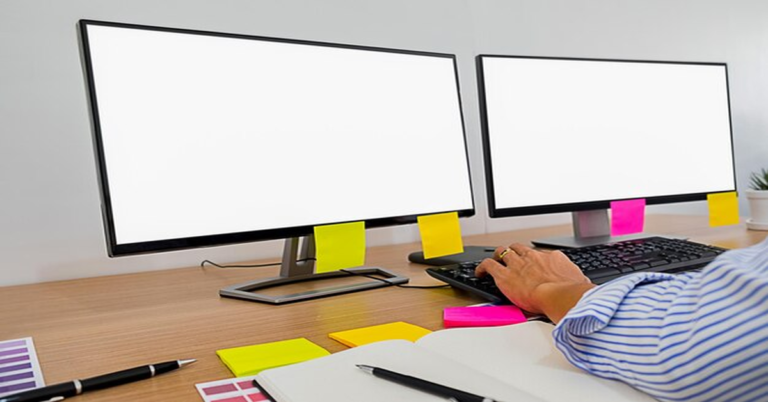A vertical computer monitor, also known as a portrait monitor, is an innovative display option that provides an alternative to the traditional landscape mode. These monitors are particularly useful for professionals, gamers, coders, writers, and designers who require a more efficient workspace. With the increasing demand for better ergonomics and productivity, vertical monitors have gained popularity across various industries. This article explores the advantages, applications, features, setup, and future trends of vertical computer monitors.
Why Choose a Vertical Monitor?
1. Enhanced Productivity
- A vertical screen enables users to view more content at once, reducing the need for excessive scrolling.
- Ideal for reading lengthy documents, coding, and handling spreadsheets.
2. Improved Ergonomics
- Reduces eye strain by minimizing excessive horizontal movement.
- Provides a more natural reading experience for digital documents.
3. Better Multitasking
- Can be paired with a standard horizontal monitor for an optimized dual-screen setup.
- Perfect for individuals managing multiple windows simultaneously.
4. Ideal for Specific Professions
- Developers & Programmers: A vertical orientation allows them to view more lines of code at once.
- Writers & Editors: Reading and editing long-form text becomes more convenient.
- Traders & Analysts: Stock charts and market data are more visible in a vertical layout.
- Graphic Designers & Photographers: Some editing tools are better suited for portrait mode.
Key Features of Vertical Monitors
1. Screen Size & Resolution
- Common sizes: 22”, 24”, 27”, and 32”.
- Higher resolutions (1080p, 1440p, 4K) improve clarity and reduce eye fatigue.
2. Adjustable Stands & Mounts
- Many monitors come with a rotatable stand to switch between portrait and landscape modes.
- VESA mount compatibility allows for flexible positioning.
3. Refresh Rate & Response Time
- Standard refresh rates: 60Hz, 75Hz, 120Hz, and 144Hz.
- Faster response times improve motion clarity for gaming and video editing.
4. Connectivity Options
- HDMI, DisplayPort, USB-C, and VGA inputs for compatibility with multiple devices.
5. Panel Technology
- IPS (In-Plane Switching): Best for color accuracy and wide viewing angles.
- TN (Twisted Nematic): Faster response times but limited color reproduction.
- VA (Vertical Alignment): Deeper blacks and better contrast, but slightly slower response times.
How to Set Up a Vertical Monitor
1. Adjusting Monitor Orientation
- Check if the monitor stand supports rotation.
- Use the built-in menu to switch to portrait mode.
2. Configuring Display Settings
- On Windows: Go to Settings > System > Display > Orientation > Select “Portrait”.
- On Mac: System Preferences > Displays > Rotation > 90° or 270°.
3. Positioning for Comfort
- Adjust height and tilt for optimal eye level.
- Use an ergonomic chair and desk setup to enhance posture.
4. Cable Management
- Organize cables using clips or sleeves to maintain a clean workspace.
Best Vertical Monitors on the Market
1. Dell UltraSharp U2723QE
- 27” 4K UHD with an ergonomic stand.
- Great for professionals needing high color accuracy.
2. ASUS ProArt PA32UCX
- 32” 4K HDR monitor with factory-calibrated colors.
- Ideal for graphic designers and video editors.
3. LG 27GN950-B
- 27” 4K Nano IPS with 144Hz refresh rate.
- Suitable for both gaming and professional use.
4. BenQ PD3200U
- 32” 4K UHD, excellent for CAD and animation professionals.
5. ASUS VG248QG
- 24” 165Hz gaming monitor with a pivotable stand.
- Affordable option for gamers and developers.
Use Cases for Vertical Monitors
1. Coding and Development
- Allows programmers to see more lines of code without excessive scrolling.
2. Reading & Writing
- Enhances readability for digital books, articles, and research papers.
3. Financial Analysis & Stock Trading
- Helps in monitoring stock charts and market movements efficiently Vertical Computer Monitor.
4. Video Editing & Content Creation
- Vertical formats align with social media content like Instagram Reels and TikTok videos.
5. Gaming
- Some games support vertical orientation for a unique experience.
Challenges and Limitations of Vertical Monitors
1. Compatibility Issues
- Not all software applications support portrait mode.
- Some websites and media may not display correctly.
2. Viewing Angles
- TN panels may not provide the best vertical viewing experience.
3. Limited Screen Real Estate
- Horizontal space is reduced, which may affect some workflows.
4. Ergonomic Adjustments
- Requires careful height and angle positioning to avoid neck strain.
Future Trends in Vertical Monitors
1. Curved Vertical Monitors
- Emerging trend in gaming and immersive experiences.
2. AI-Enhanced Display Adjustments
- Automatic brightness and color adjustments based on ambient light.
3. OLED Vertical Monitors
- Improved color accuracy and contrast for professional use.
4. Ultra-Thin Bezels
- Enhancing multi-monitor setups for better productivity.
Conclusion
A vertical computer monitor is a valuable addition to any workspace, offering improved productivity, better ergonomics, and specialized applications for various industries. While they have some limitations, the benefits outweigh the challenges for those who require an efficient and organized digital environment. With advancements in display technology, vertical monitors are set to become even more versatile and widely adopted in the coming years.
FAQs
- What are the benefits of using a vertical monitor?
- Vertical monitors improve productivity, reduce eye strain, and are ideal for coding, reading, and financial analysis.
- Can any monitor be used in vertical mode?
- Many monitors support rotation, but check if your model has a pivot function and adjustable stand.
- Are vertical monitors good for gaming?
- Some games support vertical orientation, but it depends on personal preference and game compatibility.
- What size is best for a vertical monitor?
- 24″ to 27″ is ideal for most users, while professionals may prefer larger 32″ displays.
- How do I switch my monitor to vertical mode?
- Adjust display settings on your OS and physically rotate the monitor if it supports pivoting.
- Is a vertical monitor worth it for work?
- Yes, especially for professionals in coding, writing, financial analysis, and content creation.

